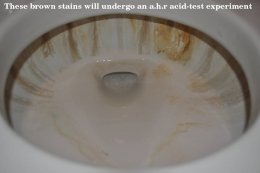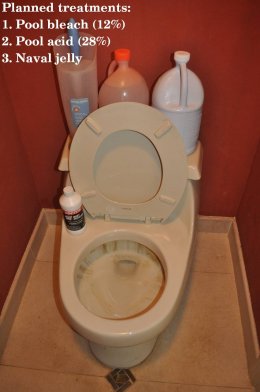Danny D.
2013-04-11 21:25:27 UTC
In another thread, it was determined that porcelain toilet
bowls were impervious to commonly available acids such as
phosphoric (Naval Jelly) & hydrochloric (pool muriatic acid).
So, I'll run an experiment to see which will remove the
brown stains best without destroying the porcelain or tile.
Here is a picture of the brown toilet bowl stains, after
scrubbing and household bleach - but before the first treatment:
Loading Image...
Here are the next three planned treatments:
Loading Image...
1. Pool bleach (12%)
2. Pool acid (28%)
3. Naval jelly
Let me know if you have any suggestions before I conduct the
experiment.
bowls were impervious to commonly available acids such as
phosphoric (Naval Jelly) & hydrochloric (pool muriatic acid).
So, I'll run an experiment to see which will remove the
brown stains best without destroying the porcelain or tile.
Here is a picture of the brown toilet bowl stains, after
scrubbing and household bleach - but before the first treatment:
Loading Image...
Here are the next three planned treatments:
Loading Image...
1. Pool bleach (12%)
2. Pool acid (28%)
3. Naval jelly
Let me know if you have any suggestions before I conduct the
experiment.